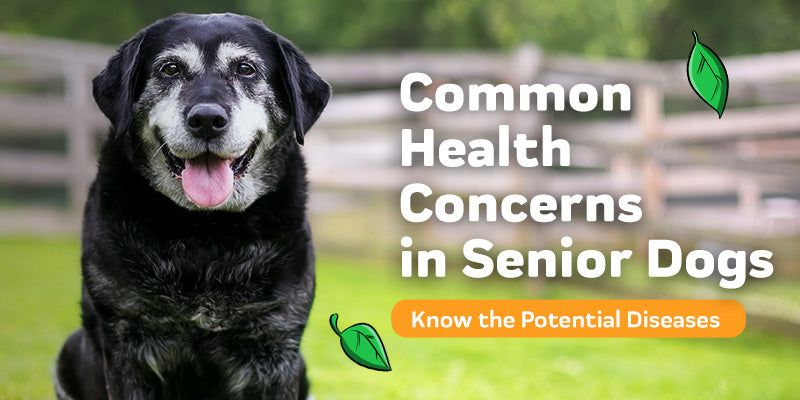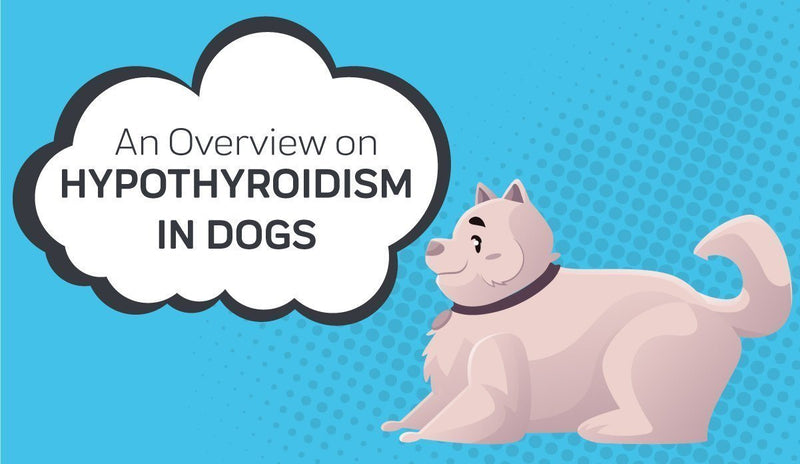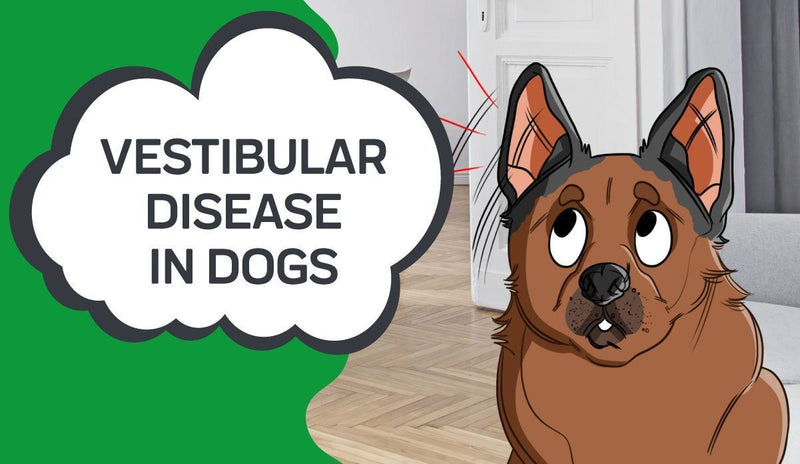- What in the World is Pyoderma?
- Predispositions Due to Genetics
- Are There Different Variations of Pyoderma for Dogs?
- Pyoderma in Dogs: Signs and Symptoms to Look Out For
- What to Do If You Don't Want to Give Your Dog Prescription Pain Medication for Pyoderma
- CBD Oil for Dogs: What is CBD and How Does it Work for Dogs?
- Where to Buy CBD Oil for Canine Pyoderma

We don’t know about you, but for us, we like to imagine a world where dogs live forever. Canines are one of those creatures that you can’t get enough of, and all dogs add value to the lives of the people around them. We can’t imagine a lifetime where dogs did not exist, and when dogs become ill, it crushes us. Talk about a heartbreaking experience. It can feel unbearable to watch your puppy pal experience illnesses and irritation, especially because you can’t take it away for them. You just have to help them through it.
As much as we wish dogs could break out of the natural circle of life and never feel pain, the truth of the matter is that dogs run into bumps down the road. They can have health concerns of their own, and as saddening as it can be, we have found that the best way to deal with sickness for dogs is to be proactive. When you act on symptoms right away, the chances of saving your dog and improving his or her overall well being skyrockets.
One of the most common ailments that many dogs run into is something called pyoderma. This is yet another instance in which seeking medical attention and care for your dog’s symptoms can be the deciding factor in whether or not your dog heals from the illness. We keep driving home the importance of taking action, but what do you do if you’re not sure what to look out for? Hoping for the best will only take you so far, and we recognize that, so we’ve compiled a blog post that talks about everything there is to know regarding the diagnosis of pyoderma.
We will discuss its origin and the various clinical signs of pyoderma that dogs contract. From there, we will mention the underlying cause of pyoderma in dogs and how the symptoms of this illness differ from other diseases with very similar warning signs. We’ll touch on a puppy pyoderma home treatment and a dog staph infection home remedy. From prescription medications to natural treatment options, pyoderma is not the end-all-be-all of your canine companion! The more you know, the more prepared you can be if pyoderma ever enters your pup’s life. Now, let’s get started!
What in the World is Pyoderma?
In and of itself, S. intermedius is not actually bad for your dog. In fact, the truth is quite the opposite. This bacteria is a naturally occurring form of bacteria found in the fur of dogs. The bacteria that cause pyoderma is so specific to dogs that, if a human contracts an infection caused by S. intermedius, it is automatically assumed that said person has had recent contact with a dog. Pyoderma is a bacterial type of skin infection in dogs that results from the buildup of a certain kind of bacteria. When young puppy dogs develop pyoderma, it is often called impetigo, though they are the same type of infection -- just at a different life stage. The bacteria responsible for canine pyoderma is called Staphylococcus intermedius, or S. intermedius.So you might be wondering how your dog can carry Staphylococcus intermedius around with him or her and not immediately become infected by the bacteria. That’s a reasonable thing to ponder. There is one circumstance that always precedes the actual infection: a decrease in the functioning of your dog’s immune system. See, the immune system works tirelessly to fight off disease and prevent infections from occurring in the first place.
However, when the immune system is not functioning at its best, infections make a home out of your pup. Without a defense to fight against all the illnesses that are trying to attack your dog, your little fluffy friend is more likely to become ill and have to deal with the consequences of a weakened immune system.
Many things can cause the immune system of dogs to weaken, including…
Immune Deficiency Disorders
- The presence of cancerous cells and tumors
- A deficiency of IgA antibodies, which actively strengthen the immune system
- Granulocyte Apathy Syndrome, which is only common in the Irish Setters breed
- Decrease of blood from bone marrow in the Gray Collies breed
Predispositions Due to Genetics
Autoimmune Disorders
- Chronic arthritis, causing weakness to spread all throughout the body
- Anemia, which is a condition where red blood cell counts are lower than usual
- Lupus, which compromises the immune system to an intense degree
Allergies
- Inflammation of the nose, resulting in something called rhinitis
- Bronchitis, which is d by irritation in the throat
- Excessive growth of mites within hair follicles
- Pneumonia, which tends to happen when colds worsen
- Flea infestations in their coats
- Dermatitis, skin infections or any other skin reactions and conditions
Are There Different Variations of Pyoderma for Dogs?
Pyoderma is a multi-tier type of skin infection. There are three different forms of pyoderma in dogs, ranging from minor pyoderma to a more severe version of the infection known as deep pyoderma. Essentially, each level represents a different seriousness in terms of how deep the pyoderma is in the skin of your dog.
Surface-level Pyoderma
This is the most easily treated form of pyoderma because it has not embedded itself in any hard-to-reach places yet. The bacteria has definitely made itself known but has yet to actually break the epidermis of your dog's coat, meaning it has not gone beyond the surface. At this point, the bacteria is bothering the external skin cells of your dog and causing irritation bacterial skin. The red parts of your dog's coat are signifying the fact that something unwanted and unwelcome is trying to make its way beneath the skin cells, so your dog's body is trying its very best to prevent this from happening.
Superficial Pyoderma
Refers to the next level of pyoderma in dogs. You can tell that surface pyoderma has graduated to superficial pyoderma because this is when dogs begin to lose hair. The bacteria enter the epidermis through the very minuscule openings of hair follicles. Hair begins to fall out as a result of these bumpy sores.
Canine superficial pyoderma poses diagnostic and therapeutic challenges due to a varied clinical presentation, but the disease can usually be treated with antibiotics. However, it is important that underlying diseases are also considered because they impair immunity or compromised skin barrier function. Failure to identify these will result in relapses even if the superficial pyoderma responds to initial treatment which may lead you to select for multidrug-resistant bacteria - one of our major threats today!
Deep Pyoderma
Deep Pyoderma is as internal as pyoderma can be. Pyoderma is considered Deep Pyoderma when the depth of infection reaches the point where it becomes deep-rooted, the bacteria responsible for deep pyoderma has inserted itself beneath the top layer of your dog’s skin. The bacteria has fully infected each hair follicle of your dog's coat, and not only does hair continue to fall out, but it also leaves bald patches on your doggy's body.
Pyoderma in Dogs: Signs and Symptoms to Look Out For
When diseases and ailments are restricted to internal organs, it can be hard to decipher what exactly is going on with your dog. This is completely understandable, too. While the signs and symptoms are there, many illnesses share the same warning signs. It gets tricky and confusing when situations are related to the inner workings of your canine. However, it is fairly easy to tell that your dog has pyoderma considering the external nature of this bacterial skin infection.
Pyoderma looks very concerning visually, but it is far worse than it appears. The infection is defined by little bumps on your dog's skin. In a way, these little raised parts of the skin look like something between a pimple and a blister. They cause the surrounding areas of your dog's coat to turn a light shade of reddish-pink.
Since pyoderma presents itself as outwardly elevated lumps on your dog’s body, you are more likely to see them or feel them when petting your pup. Aside from the physical evidence of the presence of pyoderma, the bacterial infection also causes many other symptoms for your dog.
Here is a list of things you are likely to see if your dog has pyoderma:
- Redness and irritated patches of skin under your dog’s fur
- Loss of hair in areas that appear irritated
- An odd smell coming from your dog
- Change in behavior, like an increase in aggression
- Liquid excreting from the surface of your pup’s coat
- Excessive scratching, licking or biting
What to Do If You Don't Want to Give Your Dog Prescription Pain Medication for Pyoderma

If you are not comfortable giving heavy-duty prescriptions to your dog as a way of soothing his or her symptoms of pyoderma, we don’t blame you. When you take your dog to the vet, both an antibiotic sensitivity test and a skin culture will be taken as a measure of determining which antibiotic is best for your little buddy. From there, the vet might suggest that you purchase topical ointments that contain drying agents like benzoyl peroxide. At this point, you can start to listen to your gut and determine whether you want to go the route of traditional medicine, or if a more nature and holistic route is better for your puppy. Pyoderma is more annoying and uncomfortable than it is painful. However, some veterinarians might recommend that you administer pain medication to your canine on top of the prescribed oral antibiotics. We highly recommend that you do go through with the antibiotics, particularly because this is the only way to fully treat bacterial infections, but when it comes to additional pain medicines, we are not necessarily on board with additional lab-made prescriptions for your pup.
CBD Oil for Dogs: What is CBD and How Does it Work for Dogs?
If you are leaning toward an alternative anti-inflammatory method of handling pyoderma in dogs, we have all the information you need right here about CBD oil for pyoderma. Cannabidiol -- or CBD for short -- is a compound derived from cannabis and hemp plants alike. Essentially, CBD can be used as a soothing agent in instances where there are high levels of pain and discomfort. While it is used mostly in the event of physical pain, CBD is equally as beneficial to disorders of the mind, as noted by multiple clinical studies. From generalized anxiety and panic disorders to increased stress levels and overactivity in the brain, CBD is great for managing your health. Even more related is CBD’s ability to assist with the symptoms inflicted by pyoderma.
Cannabidiol works by binding to receptors in your dog’s brain and producing a calming effect in the process. When it comes to CBD, you may already know that there are two different ways of CBD extraction. Now, before we get too carried away, we first want to mention that there are also two different plants from which CBD oils can be derived from. These plants are the cannabis plant and the hemp plant.
The plant that a particular CBD oil comes from is important because it plays a role in the overall properties of CBD. Cannabidiol oils that stem from the cannabis plant are more likely to contain trace amounts of THC, or tetrahydrocannabinol, whereas CBD derived from the Hemp plant does not contain THC in any amounts. This is first and foremost due to the fact that hemp is free of THC, but cannabis is the origin of THC. So it makes sense that CBD derived from cannabis plants might contain THC, but it’s literally impossible for hemp-based CBD to contain a single ounce of THC.
Now, let’s jump back to the topic of CBD oil extraction processes. CBD oils fall into one of two categories. CBD is either full-spectrum or an isolate. The main difference between the two is that one is entirely CBD oil, whereas the other is CBD mixed with other fellow cannabinoids and terpenes, which are responsible for the smell so often associated with weed. To be completely honest, both types of CBD can be administered to your dog, but we personally advocate more for CBD isolates.
CBD isolates are the purest form of CBD on the market. This is the type of CBD that is void of any and all other cannabinoid-related substances. It is strictly CBD oil and nothing else. The reason for our preference of CBD isolates over full-spectrum CBD oils is simply that we believe the purer, the better. There is more certainty with a CBD isolate than there is with full-spectrum CBD. Pure CBD is clearly pure, while CBD mixed with other elements of cannabis creates more room for the disparity.
Does that make sense? We hope so! To summarize, CBD is either known as an isolate, meaning it is strictly CBD, or it is considered full-spectrum, meaning it may contain very low levels of THC (legally less than 0.3%) and other useful cannabinoids. No matter which type you purchase for your pup, you can rest easy knowing that your dog will never get high from CBD.
Even with full-spectrum CBD, THC levels are never high enough to create the sensations that are associated with cannabis. One of the most defining characteristics of CBD oils is that they are not psychoactive, so if you are concerned about the possibility of getting your dog high with full-spectrum CBD, you have no reason to be!
Where to Buy CBD Oil for Canine Pyoderma
Since pyoderma is an external skin infection, you might want to consider whether or not CBD creams will irritate the outer layers of your dog's skin. The best way to make this decision is by considering how sensitive your dog's skin regularly is and how he or she has responded to lotions in the past.
If your puppy pal is not susceptible to developing rashes or reactions when introduced to new products, then CBD creams or CBD-based topical therapy may be perfectly fine for use as treatment of pyoderma for your dog. As always, if you aren't sure, we advise that you take the safest route. In this case, that would entail not using CBD cream and instead opting into oils or chews that your dog takes by mouth.

When it comes time to the treatment of pyoderma for dogs, CBD oils and CBD-based topical therapy options may be your safest bet. The thing about CBD is that it is an all-natural, additive-free medicinal remedy for dogs that can help manage pyoderma. We’ve talked about the benefits of CBD and all of its healing properties, but where do you buy CBD for dogs with pyoderma? How about checking out the products offered by Innovet?! From dog treats that contain CBD to capsules derived from hemp plants and pure CBD oils, our wide selection of CBD-infused pet products is sure to become your dog’s new favorite present.
With Innovet, you will find that all of our products are free of…
- Dyes
- By-products
- Additives
- Chemicals
- Scents
- Coloring
The ingredients for our products are always listed on the packaging, and if you have any further questions about what we use during production, please feel free to contact us! We are ready and willing to answer any questions that you send our way.
We offer nothing but the most natural and healthiest forms of CBD around! Our specialty is CBD oil for dogs. No matter how old your dog is, what breed they are, or the size of your pupper, Innovet has products that are well-suited for your fluffy, furry friend.
View our inventory for an entire list of our products and make the most educated choice when it comes to your dog. Every pup has a preference regarding the form of CBD that they like most, so follow your heart and keep your dog’s comfort level in mind when selecting CBD from Innovet!
Sources:
CBD Application Has Therapeutic Potential
Approved by:
Dr. Sara Ochoa
Doctor of Veterinary Medicine, St. Georges University

Thanks for stopping by!
P.S. We Love You!
Sincerely,
The Innovet Team
Please do not ask for emergency or specific medical questions about your pets in the comments. Innovet Pet Products is unable to provide you with specific medical advice or counseling. A detailed physical exam, patient history, and an established veterinarian are required to provide specific medical advice. If you are worried that your pet requires emergency attention or if you have specific medical questions related to your pet’s current or chronic health conditions, please contact or visit your local/preferred veterinarian, an animal-specific poison control hotline, or your local emergency veterinary care center.
Please share your experiences and stories, your opinions and feedback about this blog, or what you've learned that you'd like to share with others.
LEARN MORE
Best Selling














 CBD Oil for Dogs
CBD Oil for Dogs Advanced Mobility Support Chews for Dogs
Advanced Mobility Support Chews for Dogs All Natural Oatmeal & Honey Shampoo + Conditioner for Dogs
All Natural Oatmeal & Honey Shampoo + Conditioner for Dogs CBD Dog Treats
CBD Dog Treats




